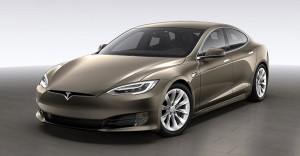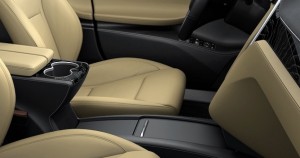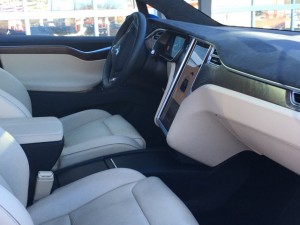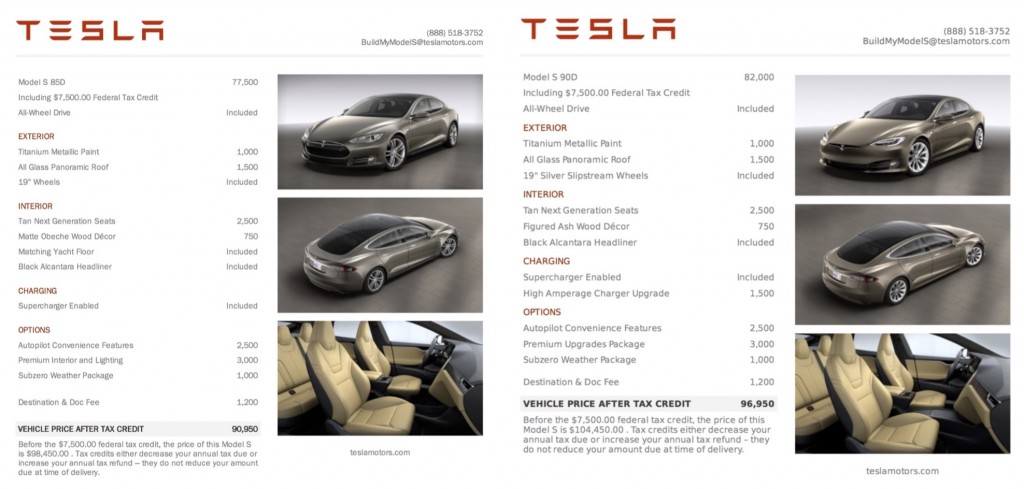News
Exploring Details Behind the Tesla Model S Update
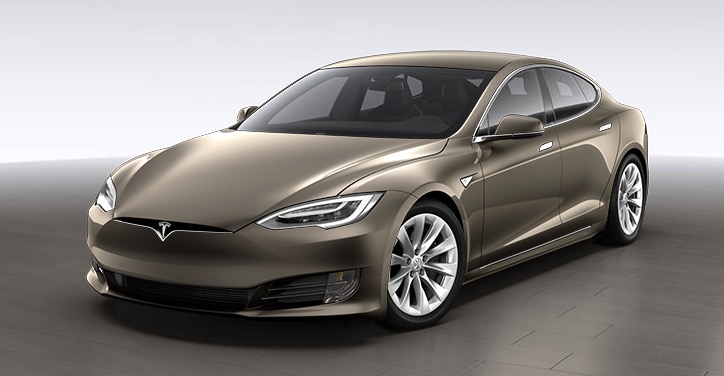
After four years on the market, Tesla has quietly released a new styling update for the Model S aligning it with the design found on the Model X and Model 3 prototype.
Tesla CEO Elon Musk has once said that Tesla continues to improve on their vehicles making sometimes twenty engineering design changes per week, with many of them being released via over-the-air software updates, but major redesigns are few and far between.
Let’s take a closer look at what the new Model S “refresh” introduced.
Exterior Design Updates
The most noticeable exterior update is the new front-end of the Model S which looks most like the front-end of the Model X.
- 2016 Tesla Model S revised front end
- Red Tesla Model X with Silver 20″ Wheels
Though they look very similar in design, the Model S looks even sleeker due to the lower profile over the Model X. The revised look keeps the Model S modern in appearance, but subtle enough that it still remains true to its original contour and body lines.
One update that easily goes unnoticed is the relocation of the front facing radar. Because of the new grill-less design of the Model S, the Tesla design team had to move the radar up from the bottom grill to the open space behind the Tesla emblem. This not only helps with functionality because of a higher mounting position with potentially less obstruction, but the new hidden location makes the car look a heck of a lot better.
Also improved on the exterior are the headlights which are now adaptive LED headlamps that adjust according to the curvature of the road. This is standard equipment found on the Model X but also seen on the Model 3 prototypes.
Interior Design Updates
The interior treatment of the Model S received a few new updates as well. Tesla has included a standard center console that looks to be the same one from the Model X.
- Revised Tesla Model S center console
- Tesla Model X Front Interior
Tesla Model S (left) vs Model X (right) interior
Tesla has also added a Figured Ash as an available interior trim. This trim has been very popular among Model X buyers, but it also happens to be a personal favorite of mine.
Additional Features
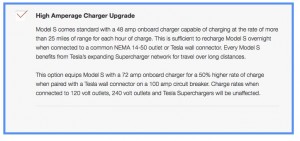 The Model S onboard charger has been upgraded from a 40A standard charger to a 48A standard charger, with an option to further increase charging rate by opting for a 72A “high amperage” charger. The older Model S configurations offered a 40A charger standard with an option to upgrade to 80A (‘dual chargers‘).
The Model S onboard charger has been upgraded from a 40A standard charger to a 48A standard charger, with an option to further increase charging rate by opting for a 72A “high amperage” charger. The older Model S configurations offered a 40A charger standard with an option to upgrade to 80A (‘dual chargers‘).
Tesla also made the automatic lift gate now a standard option which makes sense for a premium vehicle in this price range.
Included in the premium upgrade package is the BioWeapon defense mode air filtration system, as well as ambient interior lighting (previously an optional upgrade).
Pricing
While there were many rumors of a Model S price increase leading up to this design refresh, the new updates do not seem to be reflected in the price.
“The new Model S may actually be less expensive than before”
I priced out the latest Model S with options that I chose from before, and compared the new price side by side with one I previously saved.
The price from before was $98,450 and the new price is $104,450, but despite the price difference there are a couple of key differences which makes for the price disparity. Let me explain.
The last time I configured a Model S I couldn’t locate a high amperage/dual charger option so my $98,450 does not include that option. On the other hand, the updated Model S comes with a 48A charger as a standard feature. This is included in the base price of the vehicle.
Tesla also no longer offers the S85D which I priced-out back then, so this new price is for the 90D. In the past the extra 5 kWh was a $3,000 option.
If you back both of those out to the new price you get to a price difference of $99,950 or a price increase of $500. Keep in mind that the updated Model S also comes with a center console (previously a $650 extra charge) and the new air filtration system. Depending on how you look at it, the new Model S may actually be less expensive than before.
One could easily make the case that the new offering is an improvement over what Tesla offered before and is actually less expensive.
Summary
It’s great to see Tesla keeping the Model S design fresh and current despite all of the activity going on within the company, let alone conquering challenges with launching the Model X and preparing for the Model 3. Being able to pull off this current update – factoring in changes to production, logistics, service, etc – Tesla continues to defy naysayers and show the world what ingenuity and perseverance can accomplish in such a short amount of time.

Elon Musk
Elon Musk’s X will start using a Tesla-like software update strategy
The initiative seems designed to accelerate updates to the social media platform, while maintaining maximum transparency.

Elon Musk’s social media platform X will adopt a Tesla-esque approach to software updates for its algorithm.
The initiative seems designed to accelerate updates to the social media platform, while maintaining maximum transparency.
X’s updates to its updates
As per Musk in a post on X, the social media company will be making a new algorithm to determine what organic and advertising posts are recommended to users. These updates would then be repeated every four weeks.
“We will make the new 𝕏 algorithm, including all code used to determine what organic and advertising posts are recommended to users, open source in 7 days. This will be repeated every 4 weeks, with comprehensive developer notes, to help you understand what changed,” Musk wrote in his post.
The initiative somewhat mirrors Tesla’s over-the-air update model, where vehicle software is regularly refined and pushed to users with detailed release notes. This should allow users to better understand the details of X’s every update and foster a healthy feedback loop for the social media platform.
xAI and X
X, formerly Twitter, has been acquired by Elon Musk’s artificial intelligence startup, xAI last year. Since then, xAI has seen a rapid rise in valuation. Following the company’s the company’s upsized $20 billion Series E funding round, estimates now suggest that xAI is worth tens about $230 to $235 billion. That’s several times larger than Tesla when Elon Musk received his controversial 2018 CEO Performance Award.
As per xAI, the Series E funding round attracted a diverse group of investors, including Valor Equity Partners, Stepstone Group, Fidelity Management & Research Company, Qatar Investment Authority, MGX, and Baron Capital Group, among others. Strategic partners NVIDIA and Cisco Investments also continued support for building the world’s largest GPU clusters.
News
Tesla FSD Supervised wins MotorTrend’s Best Driver Assistance Award
The decision marks a notable reversal for the publication from prior years, with judges citing major real-world improvements that pushed Tesla’s latest FSD software ahead of every competing ADAS system.

Tesla’s Full Self-Driving (Supervised) system has been named the best driver-assistance technology on the market, earning top honors at the 2026 MotorTrend Best Tech Awards.
The decision marks a notable reversal for the publication from prior years, with judges citing major real-world improvements that pushed Tesla’s latest FSD software ahead of every competing ADAS system. And it wasn’t even close.
MotorTrend reverses course
MotorTrend awarded Tesla FSD (Supervised) its 2026 Best Tech Driver Assistance title after extensive testing of the latest v14 software. The publication acknowledged that it had previously criticized earlier versions of FSD for erratic behavior and near-miss incidents, ultimately favoring rivals such as GM’s Super Cruise in earlier evaluations.
According to MotorTrend, the newest iteration of FSD resolved many of those shortcomings. Testers said v14 showed far smoother behavior in complex urban scenarios, including unprotected left turns, traffic circles, emergency vehicles, and dense city streets. While the system still requires constant driver supervision, judges concluded that no other advanced driver-assistance system currently matches its breadth of capability.
Unlike rival systems that rely on combinations of cameras, radar, lidar, and mapped highways, Tesla’s FSD operates using a camera-only approach and is capable of driving on city streets, rural roads, and freeways. MotorTrend stated that pure utility, the ability to handle nearly all road types, ultimately separated FSD from competitors like Ford BlueCruise, GM Super Cruise, and BMW’s Highway Assistant.
High cost and high capability
MotorTrend also addressed FSD’s pricing, which remains significantly higher than rival systems. Tesla currently charges $8,000 for a one-time purchase or $99 per month for a subscription, compared with far lower upfront and subscription costs from other automakers. The publication noted that the premium is justified given FSD’s unmatched scope and continuous software evolution.
Safety remained a central focus of the evaluation. While testers reported collision-free operation over thousands of miles, they noted ongoing concerns around FSD’s configurable driving modes, including options that allow aggressive driving and speeds beyond posted limits. MotorTrend emphasized that, like all Level 2 systems, FSD still depends on a fully attentive human driver at all times.
Despite those caveats, the publication concluded that Tesla’s rapid software progress fundamentally reshaped the competitive landscape. For drivers seeking the most capable hands-on driver-assistance system available today, MotorTrend concluded Tesla FSD (Supervised) now stands alone at the top.
News
Elon Musk’s Grokipedia surges to 5.6M articles, almost 79% of English Wikipedia
The explosive growth marks a major milestone for the AI-powered online encyclopedia, which was launched by Elon Musk’s xAI just months ago.

Elon Musk’s Grokipedia has grown to an impressive 5,615,201 articles as of today, closing in on 79% of the English Wikipedia’s current total of 7,119,376 articles.
The explosive growth marks a major milestone for the AI-powered online encyclopedia, which was launched by Elon Musk’s xAI just months ago. Needless to say, it would only be a matter of time before Grokipedia exceeds English Wikipedia in sheer volume.
Grokipedia’s rapid growth
xAI’s vision for Grokipedia emphasizes neutrality, while Grok’s reasoning capabilities allow for fast drafting and fact-checking. When Elon Musk announced the initiative in late September 2025, he noted that Grokipedia would be an improvement to Wikipedia because it would be designed to avoid bias.
At the time, Musk noted that Grokipedia “is a necessary step towards the xAI goal of understanding the Universe.”
Grokipedia was launched in late October, and while xAI was careful to list it only as Version 0.1 at the time, the online encyclopedia immediately earned praise. Wikipedia co-founder Larry Sanger highlighted the project’s innovative approach, noting how it leverages AI to fill knowledge gaps and enable rapid updates. Netizens also observed how Grokipedia tends to present articles in a more objective manner compared to Wikipedia, which is edited by humans.
Elon Musk’s ambitious plans
With 5,615,201 total articles, Grokipedia has now grown to almost 79% of English Wikipedia’s article base. This is incredibly quick, though Grokipedia remains text-only for now. xAI, for its part, has now updated the online encyclopedia’s iteration to v0.2.
Elon Musk has shared bold ideas for Grokipedia, including sending a record of the entire knowledge base to space as part of xAI’s mission to preserve and expand human understanding. At some point, Musk stated that Grokipedia will be renamed to Encyclopedia Galactica, and it will be sent to the cosmos.
“When Grokipedia is good enough (long way to go), we will change the name to Encyclopedia Galactica. It will be an open source distillation of all knowledge, including audio, images and video. Join xAI to help build the sci-fi version of the Library of Alexandria!” Musk wrote, adding in a later post that “Copies will be etched in stone and sent to the Moon, Mars and beyond. This time, it will not be lost.”
